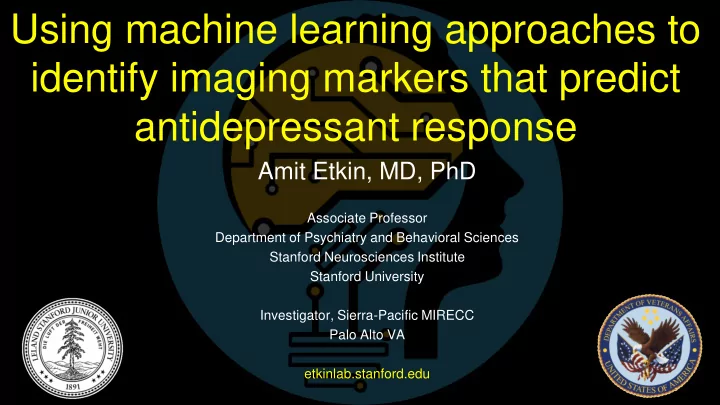

Using machine learning approaches to identify imaging markers that predict antidepressant response Amit Etkin, MD, PhD Associate Professor Department of Psychiatry and Behavioral Sciences Stanford Neurosciences Institute Stanford University Investigator, Sierra-Pacific MIRECC Palo Alto VA etkinlab.stanford.edu
Disclosures Equity (SAB): Akili Interactive, Mindstrong Health
One-size-fits-all? Can the drug define the patient? The Guardian 2/26/08 The Guardian 2/21/18
For whom does an antidepressant work? EMBARC (PIs: Trivedi, Weissman, McGrath, Parsey) : 309 depressed patients -> sertraline vs placebo All patients taken together: Depression severity (HAMD 17 ) 20 50 d=0.27 NNT=8.4 remission rate (%) 16 40 PBO 12 30 8 SER 20 4 10 0 0 0 2 4 6 8 weeks Etkin, Fonzo, Zhang, under review
Emotional conflict task Task: identify facial 1s expression, ignore ... word 3-5s + Emotional conflict 1s is biologically salient 3-5s + ... Etkin, Neuron 2006 Implicit regulation: across-trial adjustments in behavior (RT) Subjects unaware of pattern
Emotional conflict regulation circuit reactivity regulation LPFC dACC/ dmPFC insula vACC/ Etkin, Neuron 2006 vmPFC Egner, Cer Cort 2008 Etkin, Am J Psych 2010 amygdala Etkin, TICS , 2011 Etkin, Am J Psych, 2011
For whom does an antidepressant work? Emotion conflict reactivity or regulation as a moderator? • Intent-to-treat framework • Whole-brain voxelwise FDR correction • Conflict regulation but not reactivity • Unrelated to baseline clinical severity Etkin, Fonzo, Zhang, under review
For whom does an antidepressant work? Example result: Symptoms: Remission: NNT=3.4 above median below median (better regulation) (worse regulation) Depression severity (HAMD 17 ) 50 20 remission rate (%) 40 16 30 12 20 8 d=0.76 10 4 0 0 below above 0 2 4 6 8 0 2 4 6 8 PBO median median week week (better (worse SER regulation) regulation) Etkin, Fonzo, Zhang, under review
For whom does an antidepressant work? Machine learning to define a response phenotype: • Whole-brain coverage, impute HAMD 17 • Sparse Bayesian Learning, 10-fold cross-validation train test train test SER SER PBO SER Predicted HAMD 17 change (pre-post) Predicted HAMD 17 change (pre-post) 25 r=0.49 r=-0.06 p<3x10 -8 p=0.48 15 15 5 0 -5 -15 -15 -15 0 15 -15 0 15 True HAMD 17 change (pre-post) True HAMD 17 change (pre-post) Etkin, Fonzo, Zhang, under review
Predicting outcome with EEG Widge, AJP , in press
Challenges of EEG machine learning dimensionality reduction optimization volume conduction
A novel machine learning approach for outcome prediction Joint Parameter Estimation to Minimize Prediction Error Spatial Filtering Band Power Feature Linear Regression Treatment EEG Extraction Outcome C1 ∫ t ( ・ ) 2 C2 F1 S 1 ∫ t ( ・ ) 2 F2 S 2 Pz S N Constructed as a convex optimization problem Wu et al., in prep
Spatial filtering X 1 spatial filter X 0.7 Spatial filter optimization is the procedure of estimating the unknown weight coefficient of each electrode
Individual-level outcome prediction with rsEEG test test train train SER SER SER PBO Wu et al., in prep
Comparison with other models PCA alpha power test train SER SER ICA theta cordance Wu et al., in prep
Spatial patterns contributing to the prediction latent signal with latent signal with most positive most negative test train regression weight regression weight SER SER scalp spatial pattern weights - 0 + cortical spatial pattern weights - 0 + Wu et al., in prep
Predicting across sites and equipment Wu et al., in prep
Do the task fMRI and rsEEG models identify a convergent treatment-responsive phenotype? Correlate predictions in an independent depressed sample: Wu et al., in prep
Is the phenotype associated with differences in neural responsivity? latent signal with latent signal with most positive most negative regression weight regression weight Wu, Keller, HBM, 2018 Wu et al., in prep
Is the phenotype associated with differences in neural responsivity? latent signal with latent signal with most positive most negative regression weight regression weight pMFG aMFG M1 V1 right left ቐ ቐ V1 aMFG pMFG M1 aMFG pMFG M1 0-200ms 𝜄 200-400ms 400-600ms 0-200ms 𝛽 ✽ 200-400ms 400-600ms ✽ 0-200ms 𝛾 200-400ms 400-600ms 0-200ms 𝛿 ✽ 200-400ms Wu et al., in prep 400-600ms
Study stratification using our signatures Emotional conflict fMRI Resting EEG % with 5.5 point change (SER-PBO) % with 5.5 point change (SER-PBO) 60 60 50 50 40 40 30 30 Overall rate Overall rate 20 20 10 10 0 0
Acknowledgements Etkin lab Wei Wu Greg Fonzo Yu Zhang Collaborators Madhukar Trivedi & EMBARC Funding: NIMH, VA, Dana Foundation, Cohen Veterans Bioscience, Stanford Neurosciences Institute, private donors etkinlab.stanford.edu
Recommend
More recommend